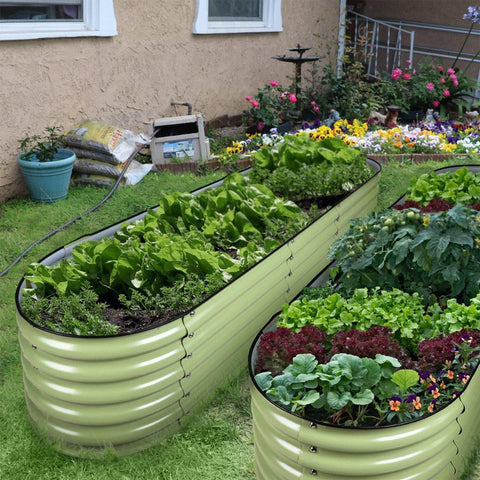Moonlight Gardens beds: Gardening by the Light of the Moon
In the world of gardening, we often associate the sun's bright rays to our green surroundings. Moonlight gardening is a different, more enigmatic method to take care of and enjoy your garden. Moonlight gardens beds are beautiful outdoor areas created to be enjoyed in the lulling, silvery light of the moon. These gardens beds come alive at night, providing gardeners and guests with a singular and enthralling experience.
In this blog, we'll delve into the interesting world of moonlight gardening, including its history, plants that do well in moonlight environments, and its advantages for both you and your garden beds.
A Brief History of Moonlight Gardens beds
The concept of moonlight gardens has ancient roots. In various cultures throughout history, gardens were designed with moonlight in mind. The idea was to create a serene and tranquil space where people could unwind and connect with nature after sunset.
One of the earliest recorded moonlight gardens is the "Korakuen Garden" in Okayama, Japan, dating back to the early 18th century. The garden features pathways illuminated by stone lanterns, enhancing the moonlight's magic. In Europe, moonlight gardens became popular during the Victorian era, characterized by fragrant white flowers, reflective pools, and ornate trellises.
Today, moonlight gardening continues to captivate gardeners and enthusiasts worldwide, offering a unique twist on traditional gardening.

Plants for Moonlight Gardens beds
Creating a moonlight garden bed involves carefully selecting plants that bloom or emit fragrances at night, enhancing the garden's ethereal ambiance. Here are some plant options to consider:
- Moon flowers (Ipomoea alba): These nocturnal beauties open their large, fragrant white blooms at night, releasing a sweet scent that attracts nighttime pollinators like moths.
- Night-blooming jasmine (Cestrum nocturnum): Known for its intoxicating fragrance, night-blooming jasmine produces small, star-shaped white flowers that perfume the air after sunset.
- Angel's trumpet (Brugmansia): With its trumpet-shaped, pendulous flowers, this plant not only adds elegance to your moonlight garden but also emits a captivating fragrance in the evening.
- Evening primrose (Oenothera biennis): This native North American plant boasts delicate yellow flowers that open as the sun sets, attracting night-flying insects.
- Lamb's ear (Stachys byzantina): Known for its soft, silver-gray foliage, lamb's ear reflects moonlight beautifully, adding a silvery glow to your garden.
- White roses: Classic and elegant, white roses, such as 'Iceberg' or 'Moonlight Magic,' add a touch of romance to your moonlight garden bed.

Creating Your Moonlight Garden bed
Designing a moonlight garden involves careful planning and attention to detail. Here are some essential steps to help you get started:
1.Select the right location: Choose an area of your garden bed that receives partial to full moonlight. Avoid areas with excessive artificial light, as it can diminish the moon's glow.
2.Design your garden layout: Consider pathways, seating areas, and focal points like a reflecting pool or a white gazebo. Use pale-colored stones or gravel for pathways to enhance the moonlight's reflection.
3.Choose moonlight-friendly plants: Opt for a variety of night-blooming and fragrant plants to create layers of interest in your garden bed.
4.Incorporate lighting: While the moon provides the primary source of light, adding soft, subtle solar-powered garden lights or lanterns can enhance the garden's magical atmosphere.
5.Accessorize: Consider adding elements like wind chimes, water features, and white or silver garden ornaments to further enhance the moonlight garden bed experience.

Benefits of Moonlight Gardening
Moonlight gardening offers numerous benefits, both for the garden and the gardener:
1.Relaxation and tranquility: Moonlight gardens provide a serene retreat, perfect for unwinding and de-stressing after a long day.
2.Enhanced sensory experience: The scents and sounds of a moonlight garden are unique and enchanting, stimulating your senses in new and exciting ways.
3.Eco-friendly: Moonlight garden beds often rely on natural light sources, making them an eco-conscious choice for gardeners.
4.Attracts nocturnal wildlife: By planting night-blooming flowers, you'll also attract beneficial nighttime pollinators like moths and bats, which can help improve biodiversity in your garden.
Moonlight gardens bed offer a captivating and mystical way to experience the beauty of nature after the sun sets. Whether you're looking for a place to unwind, connect with nature, or simply create a unique and magical outdoor space, moonlight gardening is a wonderful choice. By carefully selecting the right plants, designing your garden with the moon in mind, and appreciating the subtle beauty of moonlight, you can transform your garden into a tranquil oasis that truly shines when the night falls.
